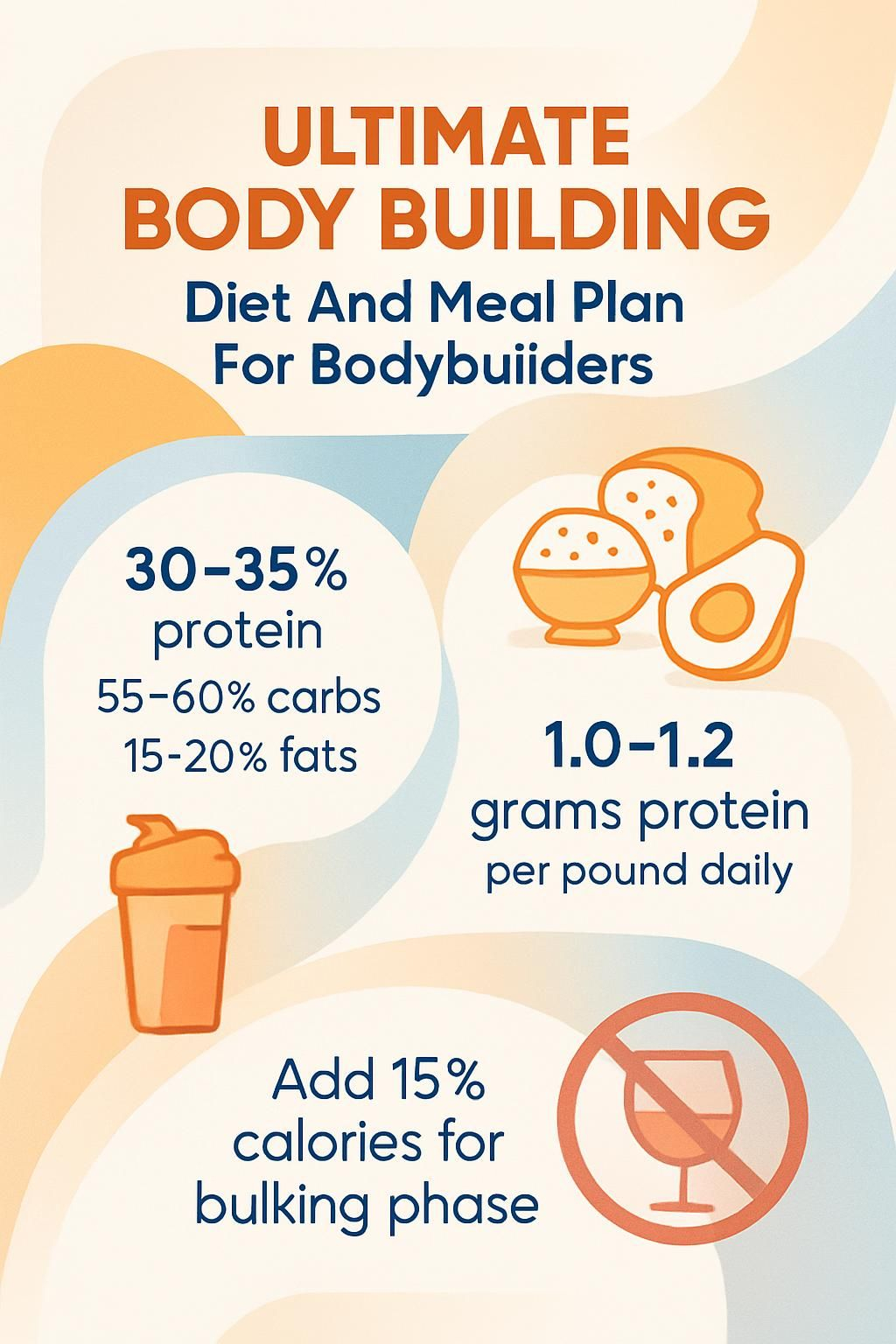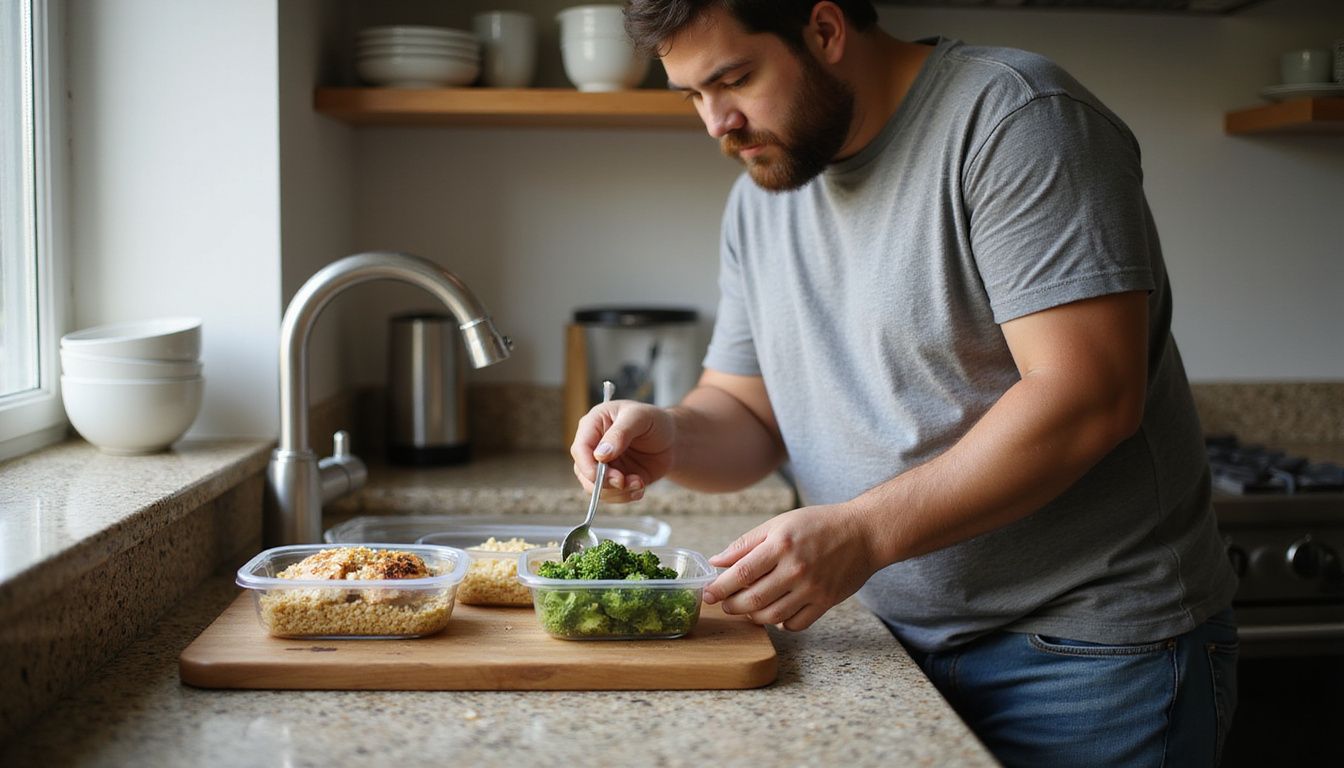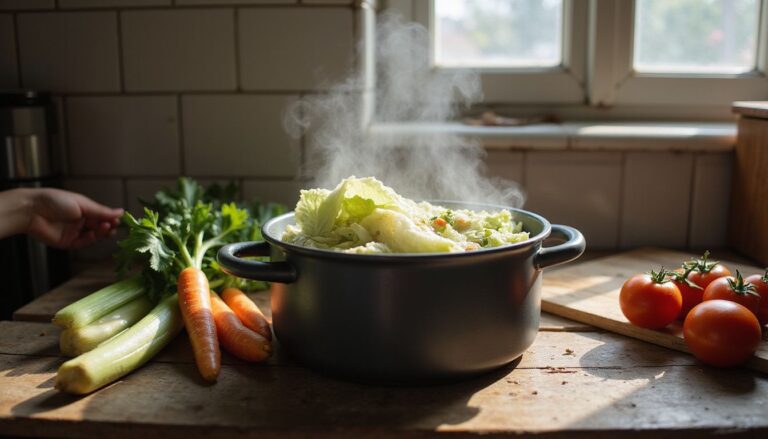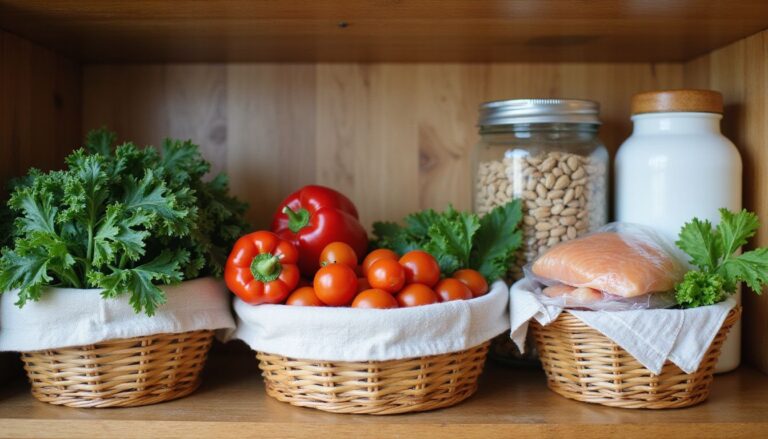Ultimate Body Building Diet And Meal Plan For Bodybuilders
Our Nutrition Assistant AI Suite will transform your body. You will lose fat, get toned, and build muscle. Gain confidence and optimal health.
You can train hard and still stall if your bodybuilding diet is off. What you eat drives muscle growth, recovery, and steady energy for every set. This guide turns the science into simple steps, from macros to a practical meal plan, so you can build muscle with confidence.
You will find clear nutrition rules, foods to eat and foods to limit or avoid, plus a 7-day bodybuilding meal plan you can start this week. Small, consistent choices shape body composition and strength over time.
Key Takeaways
- Target daily macros near 30 to 35 percent protein, 55 to 60 percent carbohydrates, and 15 to 20 percent healthy fats for muscle gain and hormone support.
- Aim for 1.0 to 1.2 grams of protein per pound of body weight each day to support muscle repair and growth.
- Limit ultra-processed foods, sugary drinks, desserts, and alcohol since excess sugar and alcohol slow recovery and can blunt gains.
- Whey protein, creatine monohydrate, BCAAs, a quality multivitamin, and omega-3s can help fill gaps and improve recovery, as supported by sports nutrition research.
- Set calories by maintenance level, then adjust. Add about 15 percent for bulking, or reduce about 15 percent for cutting.

What are the key nutrition principles for bodybuilding?

A solid bodybuilding diet starts with variety. Build meals from all food groups and focus on nutrient-dense choices. A practical target is 30 to 35 percent of calories from protein, 55 to 60 percent from carbohydrates, and 15 to 20 percent from healthy fats.
Spread protein across the day. This keeps muscle protein synthesis, the process your body uses to build new muscle, active. Plan three to five high-protein meals or snacks to cover long days and hard training.
Change weight slowly during bulk or cut phases. Aim for only 0.5 to 1 percent of body weight per week. Reducing added sugars, deep-fried food, and alcohol keeps progress steady and supports long-term health.
Working with a registered dietitian can help you set calories while keeping macros consistent as your training shifts through the year.
Essential macronutrients for bodybuilders
Protein builds and repairs muscle. Carbohydrates fuel training and refill muscle glycogen, the stored form of carbohydrates. Healthy fats support hormones that drive growth and recovery. Nailing this trio lifts results from your time in the gym.
What are the best protein sources for building muscle?
Eggs, skinless poultry, lean beef, and fish like salmon or cod supply complete proteins with all essential amino acids. Chicken breast is a lean staple that helps you hit protein targets with fewer extra calories.
Seafood such as salmon also brings omega-3s for joint comfort and recovery. Plant proteins like beans, lentils, and soy foods add protein plus fiber for appetite control and heart health.
Low-fat dairy, including Greek yogurt, cottage cheese, and milk, offers a mix of whey and casein. Whey digests fast, while casein digests slowly and can support overnight muscle repair. Protein powders make it easier to reach high daily targets, for example 259 to 302 grams on a 3,450 calorie plan.
These options keep amino acids flowing to muscles so your strength training pays off.
“Eating quality protein at every meal helps build new skeletal muscle tissue,” says sports nutritionist Dr. Susan Kleiner.
Which carbohydrates best fuel workouts?
Whole grains, starchy vegetables, and fruit power tough sessions and recovery. Oats, brown rice, quinoa, whole wheat bread, popcorn, and high-fiber cereal help refill muscle glycogen after exercise.
Starchy vegetables like sweet potatoes, corn, peas, and cassava offer fiber plus useful training fuel. For most lifters, 55 to 60 percent of daily calories from carbohydrates supports muscle-building and performance.
On a 3,450 calorie bulk, you would target roughly 474 to 518 grams of carbs. On a 2,550 calorie cut, about 351 to 383 grams works for many athletes. Prioritize starchy carbs at breakfast and post-workout for better performance and faster recovery.
What fats support hormonal balance and recovery?
After covering carbs for fuel, include the right fats for hormone health and recovery. Choose olive oil, avocados, nuts, seeds, flaxseed oil, avocado oil, and coconut oil. These fats support hormones like testosterone and help build cell membranes that adapt to training.
Get about 15 to 30 percent of daily calories from fat. On a 3,450 calorie bulk, that is about 58 to 77 grams. On a 2,550 calorie cut, aim for around 43 to 57 grams. Many options, such as nuts and seeds, provide both protein and fat in one convenient snack.
Simple upgrades help. Adding avocado to a chicken salad or a drizzle of olive oil to vegetables can improve taste and support recovery.
Recommended foods for a bodybuilder’s diet
Choosing the right foods every day does most of the heavy lifting for you. Build meals from lean proteins, fiber-rich carbs, colorful produce, and healthy fats.
Which protein-rich foods are ideal for bodybuilders?
A protein-rich diet repairs muscle after lifting. Many bodybuilders thrive at 1.0 to 1.2 grams of protein per pound of body weight.
- Lean meats like lean steak, pork tenderloin, and venison deliver high-quality protein with less fat.
- Poultry such as chicken breast and turkey provides lean protein that supports muscle function and anabolism, the building phase.
- Fish like salmon, tilapia, and cod supply protein and healthy fats. Salmon is rich in omega-3s that may aid recovery.
- Eggs and egg whites are complete proteins. Six large eggs contain more than 36 grams of protein.
- Dairy such as Greek yogurt, cottage cheese, and low-fat milk offers whey and casein, useful for day and night recovery.
- Legumes like chickpeas, lentils, black beans, and kidney beans bring plant protein and fiber that can help reduce body fat.
- Whey protein powder is a convenient tool. It absorbs quickly after tough sessions and supports muscle repair.
Next, choose the carbohydrates that keep your training strong.
What are energy-boosting carbohydrate options?
Carbohydrates are your main workout fuel and a key recovery tool. Mix slower carbs for meals and faster carbs around training.
- Whole grains like brown rice, oats, quinoa, whole grain pasta, breads, cereals, and wraps deliver steady energy.
- Starchy vegetables such as sweet potatoes, corn, peas, and cassava refill glycogen to support strength and size.
- Fruits including bananas, oranges, apples, grapes, and berries offer quick-digesting sugars for training and vitamins for health.
- Popcorn is a light whole grain snack that fits into a balanced plan.
- Oatmeal provides long-lasting energy for lifting and cardio.
- Whole grain crackers and cereals are easy options for stable blood sugar across the day.
- Quinoa brings slow carbs and all nine essential amino acids in one grain-like seed.
Match carb type to your needs. Use slower carbs at meals for steady energy and faster carbs near workouts for better performance.
Which nutritious fats should bodybuilders include?
Healthy fats support hormone production, nutrient absorption, and joint comfort. They also add flavor, which makes consistency easier.
- Use olive oil, flaxseed oil, avocado oil, and coconut oil for cooking or salads. They provide heart-friendly fats that support growth.
- Add almonds or walnuts to snacks. One ounce of almonds gives about 6 grams of protein with healthy fats.
- Spread peanut or almond butter on whole grain toast for a calorie-dense snack that supports a bulk.
- Sprinkle chia, flax, or sunflower seeds into oatmeal or smoothies. One tablespoon of chia offers roughly 4 grams of fat.
- Include avocados. One medium avocado provides about 20 grams of fat plus fiber and vitamins.
- Eat fatty fish or consider omega-3 supplements to reduce soreness and support cell repair.
- Rotate sources. Use coconut oil for some saturated fats, olive oil for monounsaturated fats, and flax or walnuts for polyunsaturated fats.
What vegetables and fruits provide vital micronutrients?
Colorful produce brings vitamins, minerals, and antioxidants that support recovery and performance. Mix different colors through the week.
- Broccoli provides vitamin C, vitamin K, potassium, and fiber. It helps counter exercise-related oxidative stress.
- Leafy greens like spinach and kale supply iron, folate, magnesium, and calcium for blood and muscle function.
- Tomatoes offer vitamin C, lycopene, and potassium, which support heart health and may reduce inflammation.
- Green beans contribute fiber, folate, and minerals that aid glucose metabolism.
- Oranges deliver vitamin C for collagen formation during muscle repair and also help with hydration.
- Apples supply antioxidants that support heart health during intense training blocks.
- Bananas deliver potassium that helps with fluid balance and reduces cramps.
- Berries, especially blueberries, contain vitamins A and C plus antioxidants that may reduce soreness.
- Grapes contain resveratrol, which supports healthy blood vessels for nutrient delivery.
- Peppers add vitamins A and E that support immune defenses during hard training phases.
A simple tip, pack cut fruit or cucumbers for post-gym snacks. They add water and micronutrients while you recover.
Which foods should bodybuilders reduce or avoid?
Your food choices shape your results. Some options work against muscle growth and steady weight control.
Why avoid processed foods in bodybuilding diets?
Processed foods are often high in calories and low in nutrients. Candy, cake, cookies, and soft drinks bring excess sugar, sodium, and poor-quality fats.
These choices raise the chance of gaining body fat instead of lean muscle. They can also spark cravings that make a calorie deficit harder during a cut.
Research links ultra-processed foods with greater fat gain and weaker diet adherence over time. Even sugary sports drinks and bars can spike blood sugar, then crash energy.
Cutting back on these products can improve portion control and make recovery more predictable during prep.
How do sugary drinks and desserts impact bodybuilding?
Sugary drinks and desserts add empty calories that displace nutrient-dense foods. Items like cookies, doughnuts, ice cream, cake, and soda rarely support muscle goals.
High added sugar intake makes it harder to gain weight from lean mass. It also increases inflammation, which may slow recovery and fat loss. A 2022 review linked high-sugar diets with poorer body composition outcomes for athletes.
Choose whole foods first. Eggs, chicken, fish, beans, potatoes, and fruit support training better than a daily dessert habit.
What are the effects of alcohol on muscle growth?
Alcohol makes building muscle harder. It can reduce muscle protein synthesis, which is how your body repairs and builds new muscle after training.
Studies show alcohol can lower growth hormone and disrupt testosterone. Both are important for recovery and hypertrophy. Alcohol also harms sleep and immune function, which delays recovery. The extra liquid calories raise fat gain risk during social weekends.
If you do drink, keep it rare and moderate. Many lifters notice weaker performance the day after a night out.
Supplements to enhance bodybuilding results
Supplements can help you cover gaps in a healthy diet. Focus on options with strong research support, and use them to complement, not replace, real food.
What are the benefits of whey protein supplements?
Whey protein is a fast-digesting protein that helps you meet daily protein goals. It is convenient after workouts when your muscles are primed for repair.
Studies show that enough high-quality protein supports faster recovery and more lean mass from training. If your schedule is busy, whey makes it simple to hit targets without relying on processed snacks.
One scoop mixed with water or milk is an easy win. Many sports dietitians include whey in evidence-based plans for both men and women who lift.
How does creatine support muscle development?
Creatine monohydrate increases the stored energy in your muscles. This boost supports more reps at a given weight, leading to greater strength and size over time.
Research consistently shows creatine helps increase muscle mass and supports performance through tough sets. It also fits many eating styles, including low-carb or higher-carb plans.
When should BCAAs be used for energy and recovery?
Branched-chain amino acids, or BCAAs, can help during calorie cuts when muscle breakdown risk is higher. Taking them before or during training may protect muscle and support endurance.
If you train several days in a row or feel unusually fatigued, BCAAs might reduce soreness. Many athletes sip BCAAs during long sessions in a cut, especially when carbs are lower.
Use this tactic to preserve lean mass while you focus on fat loss.
Why take multivitamins daily for bodybuilding?
Hard training increases your need for certain vitamins and minerals. A daily multivitamin helps cover common gaps when calories are tight or variety is limited.
Research notes frequent shortfalls in vitamin D, vitamin B12, iron, zinc, and magnesium among athletes. Low intake can cause fatigue, poor focus in the gym, and slower gains. A broad-spectrum multivitamin lowers this risk and supports immune function during heavy blocks.
Whole foods come first, but a daily multi is an effective safety net when stress and training volume climb.
References:
1: Gleeson M., “Immune Function in Sport”, Journal of Sports Sciences (2013).
2: California Air Resources Board (CARB), Nutrition Guidelines for Athletes (2020).
What benefits do omega-3 fatty acids offer?
Omega-3 fats from fatty fish, flaxseed oil, chia seeds, and walnuts can reduce exercise-related inflammation. Lower inflammation supports quicker recovery and less soreness after training.
Omega-3s also improve heart markers such as blood pressure and triglycerides. A 2022 meta-analysis in the Journal of the International Society of Sports Nutrition found athletes using omega-3s had less post-workout soreness.
Many lifters feel better joints and faster recovery with about 2 grams of fish oil per day. These fats also support steady hormones during hard training phases.
How do you calculate caloric needs for bodybuilding?
Accurate calories keep progress steady while limiting fat gain in a bulk and muscle loss in a cut. Your age, weight, height, activity level, and goals guide the target.
How to calculate a calorie surplus for muscle gain?
- Find maintenance calories. Track your intake and weight for about two weeks. If your weight stays stable, you have your baseline.
- Add a surplus. Multiply maintenance calories by 0.15 for a 15 percent increase.
- Example: 3,000 maintenance calories times 0.15 equals 450. Eat about 3,450 calories per day.
- Monitor intake with a food diary or app. Hit the target consistently to activate growth.
- Weigh in weekly. Adjust up or down if you gain fat too quickly or progress stalls.
- Seek help from a registered dietitian if tracking causes stress or if you notice body image concerns.
- Fill the surplus with lean protein, complex carbs, and healthy fats. Avoid making up calories with junk food.
How to adjust calories for cutting or bulking phases?
- Estimate maintenance with a trusted calculator, then verify with two weeks of tracking.
- For a bulk, add about 300 to 500 calories per day above maintenance to support steady gains.
- For a cut, reduce calories by about 15 percent. Example: 3,450 times 0.15 equals about 517. Eat near 2,550 calories per day.
- Aim to gain or lose 0.5 to 1 percent of body weight per week to protect muscle.
- Reassess monthly. Update targets if weight shifts too quickly or progress stalls.
- Keep protein high at 1.0 to 1.2 grams per pound of body weight. Use more carbs for bulking performance. Trim carbs slightly during a cut, and increase vegetables for volume.
Dialing in calories and macros sets up the meal plan to work every week.
Sample 7-day meal plan for bodybuilders
This sample plan shows how to turn targets into plates. Mix and match portions to fit your calories and macro goals.
What meals are included on Day 1?
Breakfast: scrambled eggs, oatmeal, and stir-fried vegetables for protein and complex carbs. Mid-morning snack: a whey protein shake for fast amino acids.
Lunch: grilled chicken, mixed greens, and a baked sweet potato for fiber, vitamins, and slow-digesting carbs. Afternoon snack: hard-boiled eggs, carrot sticks, and whole grain crackers.
Dinner: broiled fish with green beans and brown rice for omega-3s and steady fuel. This lineup supports recovery and keeps energy even through the day.
What meals are included on Day 2?
Breakfast: Greek yogurt with berries and granola for about 20 grams of protein and antioxidants. Snack: a protein smoothie with protein powder, banana, and almond milk.
Lunch: a lettuce-wrapped burger with tomato, pickle, and mustard to keep carbs modest while hitting protein. Post-workout: a protein bar or shake.
Dinner: shrimp sautéed with spinach over brown rice to combine lean protein and complex carbs for recovery.
What meals are included on Day 3?
Breakfast: oatmeal mixed with protein powder and topped with nuts for slow carbs and quality protein. Snack: sliced turkey with cucumber for a lean bite.
Lunch: grilled salmon, quinoa, and steamed broccoli for omega-3s, complex carbs, and fiber. Snack: cottage cheese with apple slices for a steady casein source.
Dinner: chicken breast with roasted yams and asparagus to refill glycogen and deliver key micronutrients like folate and vitamin K.
What meals are included on Day 4?
Breakfast: an egg white and spinach omelet for lean protein and iron. Snack: almonds and blueberries for healthy fats and antioxidants.
Lunch: lean beef stir-fry with brown rice and snap peas for protein, fiber, and B vitamins. Snack: low-fat Greek yogurt for a protein boost.
Dinner: baked cod with sweet potato and mixed vegetables for omega-3s and steady carbs to refuel muscles after training.
What meals are included on Day 5?
Breakfast: protein pancakes with fresh berries for muscle support and antioxidants. Snack: hummus with carrot sticks for fiber and healthy fats.
Lunch: tuna salad over mixed greens with tomatoes for lean protein and micronutrients. Snack: a protein shake with banana for quick energy.
Dinner: grilled chicken breast, quinoa, and roasted Brussels sprouts for complete protein, whole grains, and vitamins C and K.
What meals are included on Day 6?
Breakfast: scrambled eggs, mushrooms, and two slices of whole grain toast for recovery and steady energy. Snack: low-fat cheese with a handful of grapes.
Lunch: turkey chili with kidney beans over brown rice for lean protein and complex carbs. Post-workout: a whey protein shake.
Dinner: baked salmon with roasted potatoes and steamed green beans for omega-3s, fiber, and essential minerals.
What meals are included on Day 7?
Breakfast: oatmeal with diced pears and a scoop of protein powder mixed in. Snack: Greek yogurt topped with walnuts for protein and healthy fats.
Lunch: grilled shrimp with jasmine rice and steamed broccoli for lean protein, complex carbs, and fiber. Snack: an apple with almond butter.
Dinner: lean pork tenderloin, mashed sweet potatoes, and asparagus for protein, antioxidants, and slow-digesting carbs.
Strategies for effective meal prep
Meal prep keeps you consistent and saves time on busy days. A little planning each week makes hitting macros far easier.
What are the best tips for batch cooking?
Cook proteins like chicken, ground turkey, or tofu in bulk. Prepare grains such as rice and quinoa ahead of time. Roast or steam several vegetables at once to cover multiple meals.
Use portion-controlled containers to track calories and macros with less effort. Rotate seasoning blends and sauces with minimal added calories to prevent flavor burnout. Set aside two hours once or twice a week, and most of your plan is ready.
How to store meals and control portions effectively?
Store meals in the fridge for up to three days, or freeze for longer. Label each container with the date and contents to avoid waste.
Pre-portioned meals reduce overeating and keep progress steady in both bulking and cutting phases. Studies show portion control improves diet success, and many lifters find it reduces stress during the workweek.
How to maintain variety and consistency in meals?
Rotate protein sources such as chicken, lean beef, fish, tofu, eggs, and Greek yogurt. Swap complex carbs through the week, for example brown rice, sweet potatoes, oats, whole grain pasta, and quinoa.
Add at least three different vegetables daily and change them often. Use spices and fresh herbs for variety without extra calories. Plan weekly menus so you cover macros while cycling seasonal produce and new recipes.
Keep a simple food log. Tracking helps you spot patterns and stay consistent across long training cycles.
What are the advantages of a structured bodybuilding diet?
A structured plan powers training and makes results more predictable. Clear targets reduce guesswork, which helps you focus on lifting and recovery.
How does it promote muscle growth and recovery?
Enough protein, carbohydrates, and healthy fats support both growth and repair. Eating around 2.3 to 3.1 grams of protein per kilogram of lean body mass gives your muscles the raw materials to rebuild.
Carbohydrates at 55 to 60 percent of calories refuel glycogen so you can train hard tomorrow. Healthy fats at 15 to 20 percent support hormone production, including testosterone, which drives growth and recovery.
How does it boost overall health and energy?
A nutrient-rich plan lowers the risk of chronic disease, as outlined in the Dietary Guidelines for Americans. Balanced macros deliver steady energy for workouts and life.
Hydration and produce variety strengthen immune defenses. Limiting ultra-processed foods supports consistent energy and better long-term health.
What considerations and risks come with bodybuilding diets?
Progress takes patience and care. Pushing too hard with training or restriction raises risk and can set you back.
What are the risks of overtraining and nutritional deficits?
Overtraining can lead to nagging injuries, frequent illness, sleep issues, and constant fatigue. Very low body fat can also hurt sleep, mood, and immune function.
Severe calorie cuts raise the risk of vitamin and mineral shortfalls. That slows recovery, hurts performance, and can reduce training quality. A balanced plan is safer and sustains progress longer than extreme approaches.
What dangers are associated with supplement misuse or steroids?
Overusing supplements or taking anabolic steroids can cause serious harm. Risks include heart problems, high blood pressure, mood changes, and reduced fertility.
Supplements that are not third-party tested may contain contaminants. Choose certified products and follow label directions. If side effects appear, stop and speak with a health professional.
Conclusion
A smart bodybuilding diet gives you the fuel to train hard, recover well, and build muscle at a steady pace. Balanced macronutrients, a realistic calorie plan, and a consistent meal plan help during both bulking and cutting phases.
Focus on nutrient-dense foods, limit processed items and alcohol, and use supplements such as whey protein and creatine for targeted support. Meal prep turns good intentions into daily action. If you have medical conditions, or if tracking raises stress, talk with a registered dietitian for personalized guidance.
This article is for education only and is not medical advice. Use these steps to shape a practical bodybuilding meal plan that fits your goals and supports long-term health.
FAQs
1. What is the best meal plan for bodybuilders aiming to gain muscle?
A structured bodybuilding diet includes lean meats, eggs, dairy products, whole grains, fruits, and vegetables. Research shows that eating 1.6 to 2.2 grams of protein per kilogram of body weight each day helps support muscle growth and repair [Phillips & Van Loon, 2011]. Meals should be spaced every three to four hours for steady energy.
2. How many calories should a bodybuilder eat daily?
Calorie needs depend on age, gender, activity level, and training intensity. Most male athletes require between 3,000 and 4,000 calories per day during intense training periods [Rodriguez et al., 2009]. Female athletes may need fewer calories but still must meet their energy demands for performance.
3. Which foods help with recovery after workouts?
Foods rich in protein like chicken breast or cottage cheese paired with carbohydrates such as brown rice or sweet potatoes aid recovery by restoring glycogen stores and repairing muscles [Ivy & Portman, 2004]. Including antioxidant-rich produce like berries can also reduce inflammation.
4. Can supplements replace whole foods in a bodybuilding diet?
Supplements such as whey powder or creatine monohydrate can fill nutritional gaps; however they do not offer the same range of vitamins and minerals found in natural foods [Kerksick et al., 2017]. A balanced approach combines both food sources and targeted supplementation when needed.
Summary: An effective bodybuilding meal plan uses nutrient-dense foods at regular intervals while meeting calorie targets based on individual needs. Protein intake supports muscle growth; carbohydrate timing aids recovery; supplements play a supporting role but cannot fully substitute real food choices.







